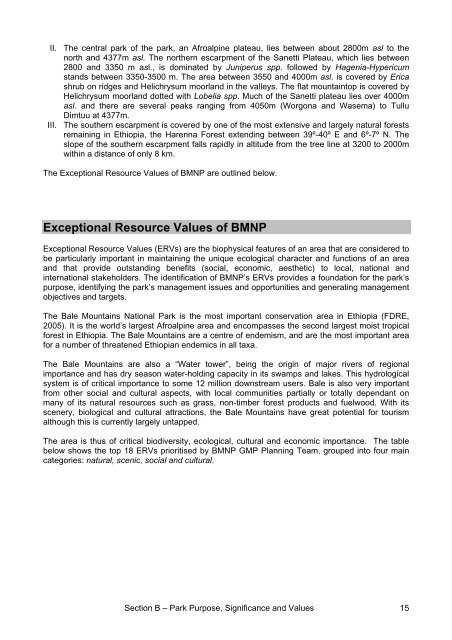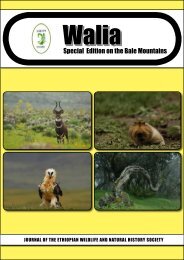Bale Mountains National Park - Zoologische Gesellschaft Frankfurt
Bale Mountains National Park - Zoologische Gesellschaft Frankfurt
Bale Mountains National Park - Zoologische Gesellschaft Frankfurt
Create successful ePaper yourself
Turn your PDF publications into a flip-book with our unique Google optimized e-Paper software.
II. The central park of the park, an Afroalpine plateau, lies between about 2800m asl to the<br />
north and 4377m asl. The northern escarpment of the Sanetti Plateau, which lies between<br />
2800 and 3350 m asl., is dominated by Juniperus spp. followed by Hagenia-Hypericum<br />
stands between 3350-3500 m. The area between 3550 and 4000m asl. is covered by Erica<br />
shrub on ridges and Helichrysum moorland in the valleys. The flat mountaintop is covered by<br />
Helichrysum moorland dotted with Lobelia spp. Much of the Sanetti plateau lies over 4000m<br />
asl. and there are several peaks ranging from 4050m (Worgona and Wasema) to Tullu<br />
Dimtuu at 4377m.<br />
III. The southern escarpment is covered by one of the most extensive and largely natural forests<br />
remaining in Ethiopia, the Harenna Forest extending between 39º-40º E and 6º-7º N. The<br />
slope of the southern escarpment falls rapidly in altitude from the tree line at 3200 to 2000m<br />
within a distance of only 8 km.<br />
The Exceptional Resource Values of BMNP are outlined below.<br />
Exceptional Resource Values of BMNP<br />
Exceptional Resource Values (ERVs) are the biophysical features of an area that are considered to<br />
be particularly important in maintaining the unique ecological character and functions of an area<br />
and that provide outstanding benefits (social, economic, aesthetic) to local, national and<br />
international stakeholders. The identification of BMNP’s ERVs provides a foundation for the park’s<br />
purpose, identifying the park’s management issues and opportunities and generating management<br />
objectives and targets.<br />
The <strong>Bale</strong> <strong>Mountains</strong> <strong>National</strong> <strong>Park</strong> is the most important conservation area in Ethiopia (FDRE,<br />
2005). It is the world’s largest Afroalpine area and encompasses the second largest moist tropical<br />
forest in Ethiopia. The <strong>Bale</strong> <strong>Mountains</strong> are a centre of endemism, and are the most important area<br />
for a number of threatened Ethiopian endemics in all taxa.<br />
The <strong>Bale</strong> <strong>Mountains</strong> are also a “Water tower”, being the origin of major rivers of regional<br />
importance and has dry season water-holding capacity in its swamps and lakes. This hydrological<br />
system is of critical importance to some 12 million downstream users. <strong>Bale</strong> is also very important<br />
from other social and cultural aspects, with local communities partially or totally dependant on<br />
many of its natural resources such as grass, non-timber forest products and fuelwood. With its<br />
scenery, biological and cultural attractions, the <strong>Bale</strong> <strong>Mountains</strong> have great potential for tourism<br />
although this is currently largely untapped.<br />
The area is thus of critical biodiversity, ecological, cultural and economic importance. The table<br />
below shows the top 18 ERVs prioritised by BMNP GMP Planning Team, grouped into four main<br />
categories: natural, scenic, social and cultural.<br />
Section B – <strong>Park</strong> Purpose, Significance and Values 15
















